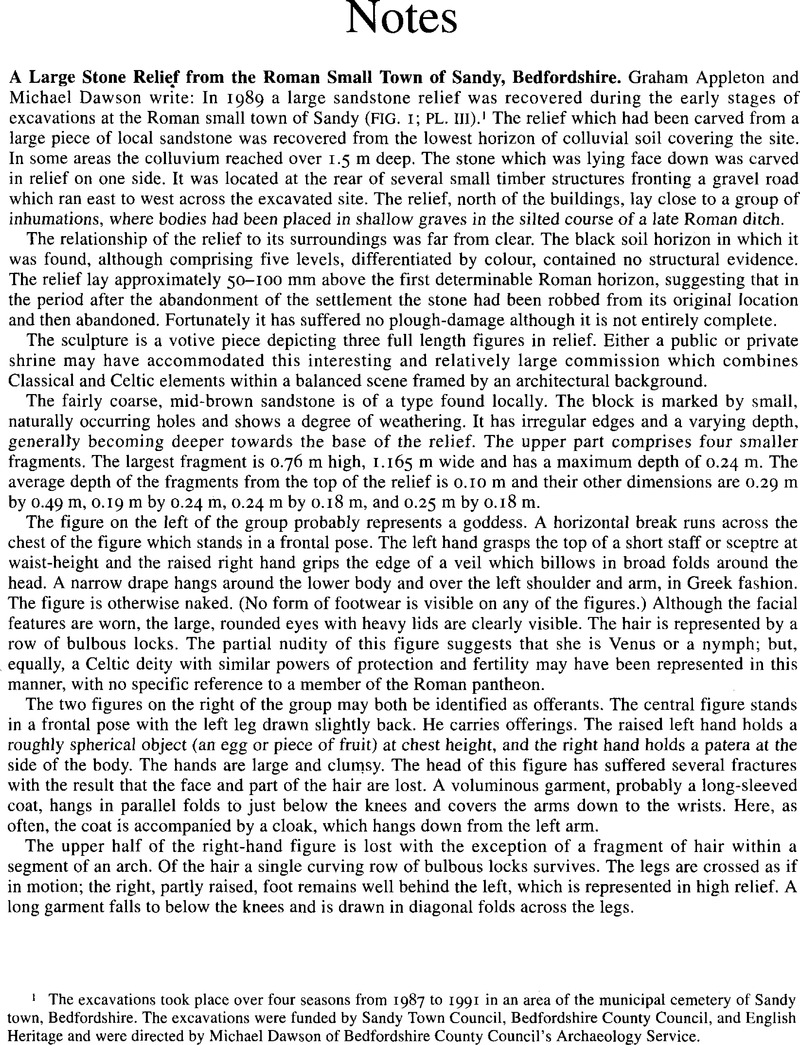Article contents
A Large Stone Relief from the Roman Small Town of Sandy, Bedfordshire
Published online by Cambridge University Press: 09 November 2011
Abstract

- Type
- Notes
- Information
- Copyright
- Copyright © Graham Appleton and Michael Dawson 1995. Exclusive Licence to Publish: The Society for the Promotion of Roman Studies
References
1 The excavations took place over four seasons from 1987 to 1991 in an area of the municipal cemetery of Sandy town, Bedfordshire. The excavations were funded by Sandy Town Council, Bedfordshire County Council, and English Heritage and were directed by Michael Dawson of Bedfordshire County Council's Archaeology Service.
2 J.C. Coulston and E.J. Phillips, Corpus Signorum Imperii Romani. Great Britain I.vi Hadrian's Wall West of the North Tyne, and Carlisle (1988), 162–3, no. 486.
3 Frere, S.S., ‘A Romano-British relief from Keisby, Lines’, Antiq. Journ. xliii (1963), 292, pl. xlviiia; idem, ‘Some Romano-British sculptures from Ancaster and Wilsford, Lincolnshire’, Antiq. Journ. xlv (1961), 229–30, pl. xla; J. Huskinson, CSIR. Great Britain I.viii Eastern England (forthcoming), nos 19 and 20.CrossRefGoogle Scholar
4 L.F. Pitts, Roman Bronze Figurines of the Catuvellauni and Trinovantes, BAR Brit. Ser. 60 (1979), 27, nos 121 and 132, pls 20 and 23.
5 B.W. Cunliffe and M.G. Fulford, CSIR. Great Britain I.ii Bath and the Rest of Wessex (1982), 32–3, no. 116, pl. 31 (Wellow); 11, no. 39, pl. II (Bath).
6 G. Faider-Feytmans, Recueil des bronzes de Bavai, 8th suppl. to Gallia (1957), 62, no. 79, pl. xix; S. Boucher, Recherches sur les bronzes figurés de Gaul pré-romaine et romaine (1976), 53, fig. 71.
7 É. Espérandieu, Recueil général des bas-reliefs, statues et bustes de la Gaule romaine (1907–34), II, 405, no. 1618; III, 190, no. 2117; XI, 35, no. 7698.
8 J.P. Wild, ‘The Clothing of Britannia, Gallia Belgica and Germania Inferior’, Aufstieg und Niedergang der römischen Welt II.12.3 (1985), 369–74. Cf. Espérandieu, op. cit. (note 7), III, 272, no. 2309 and VI, 305, no. 5117 for similar pose, and for representation of Gallic cape and coat, respectively.
9 Espérandieu, op. cit. (note 7), XI, 77–90, 92–4, esp. nos 7760–2, 7765–7, 7770–1, 7774, 7777. Cf. no. 7762 for the approaching attendant; also ibid., III, 280, no. 2326 for an altar with relief of a single turning figure carrying a patera.
10 ibid., XI, 77–8, no. 7760; also cf. 91, no. 7773.
11 Cunliffe and Fulford, op. cit. (note 5), 32–3, no. 116 (Wellow) and 34, no. 120, pl. 31 (Easton Grey).
12 Green, H.J.M. and Henig, M., ‘A Roman bronze figurine from Earith, Cambridgeshire’, Journ. Brit. Arch. Ass. cxli (1988), 159–61, pl. xvii A–D.CrossRefGoogle Scholar
13 For a summary of inscriptions relating to Genii, J.P. Alcock, ‘The Concept of Genius in Roman Britain’, in M. Henig and A. King (eds), Pagan Gods and Shrines of the Roman Empire (1985), 116–20, Tables 1–4.
- 1
- Cited by


